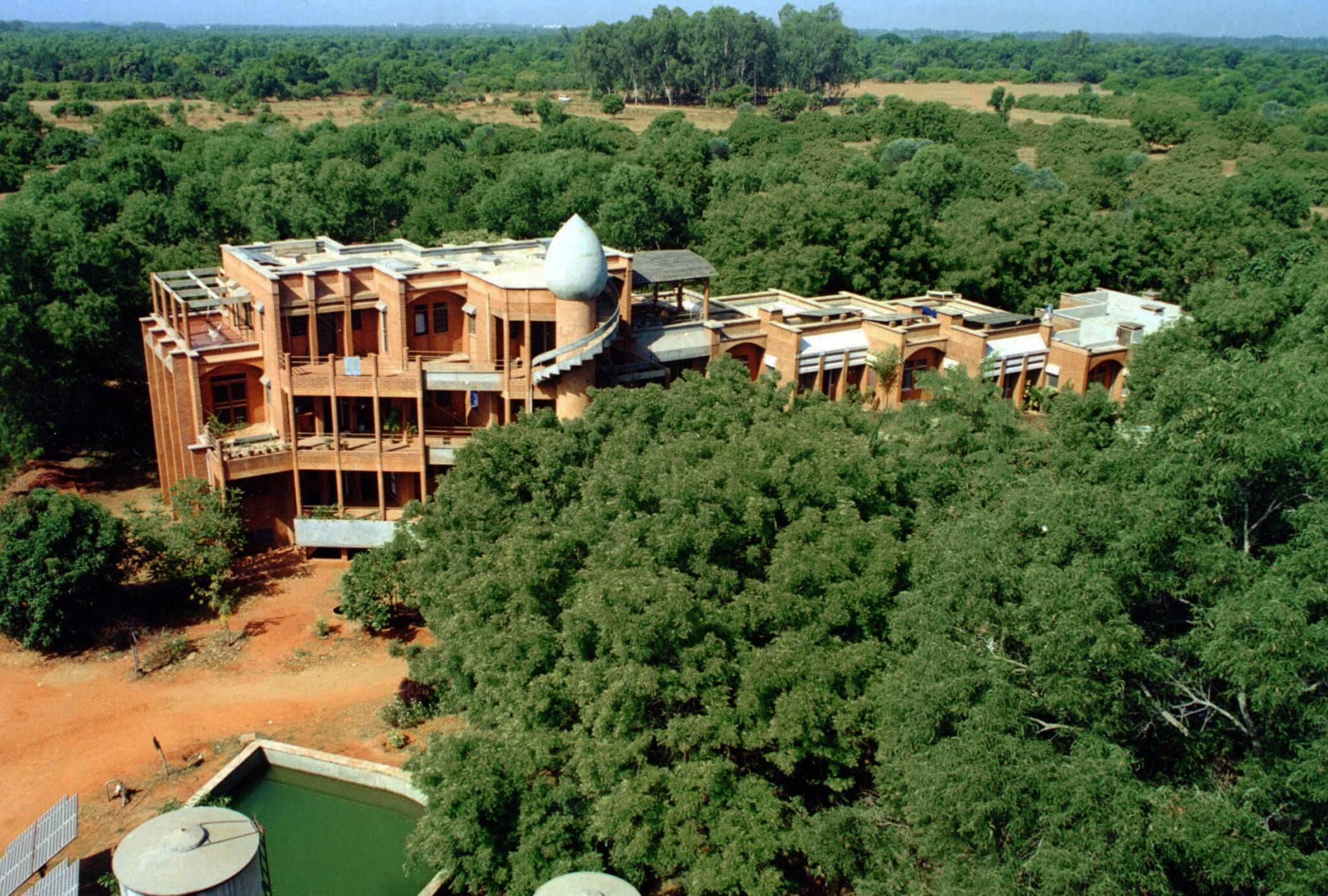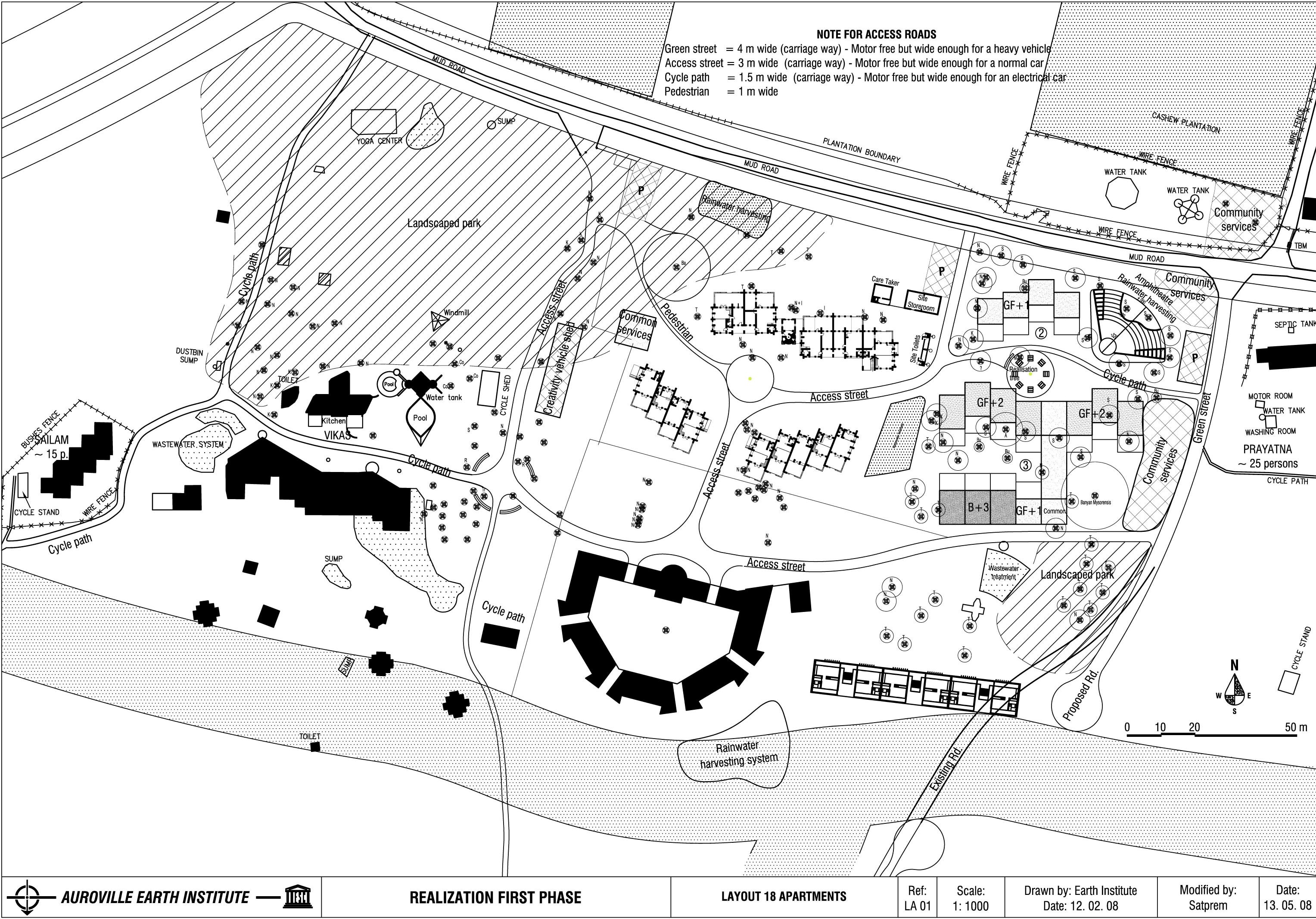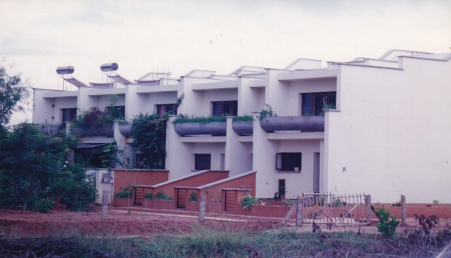Spirit of VIKAS

The first residential development in Auroville to use stabilised earth right from foundation to the roof
The creation of Vikas (which means “Progress” in Hindi) was based on a particular spirit, lifestyle and appropriate architectural design. It was related to Sri Aurobindo’s integral yoga and Auroville’s ideal. The extensive use of environmentally sound materials, appropriate building technologies, (earth and ferrocement), renewable energies (solar and wind) and ecological water management (watershed harvesting and biological waste water treatment), were the basis of its material implementation. Individual apartments, a few individual houses and common facilities were built. This project was the first development in Auroville, which used stabilised earth right from foundations to roof. To date, Vikas community still represents the most synthetic holistic development, which has been materialised in Auroville.
The community was built in several steps, from 1992 to 1998, and the third block of thirteen apartments was built on four floors: a basement floor with three floors above it. The concept of this building was such that it would be self-sufficient for its soil needs. The soil was dug from the basement floor (1.20m below the original ground level) to produce compressed stabilised earth blocks for building the structure of 819 m2, carpet area, on 4 floors. The foundations were done with stabilised rammed earth and the 13.40m high walls were done with CSEB of 24 cm thick. All floors and roofs were made of very flat vaults and domes for the living rooms. These vaults and domes were built with CSEB, by using the “Free-spanning” technique. All stabilisation used 5 % cement by weight. The experiment of Vikas found its roots in Auroville’s ideals. Nonetheless, its material developments could be implemented elsewhere in the world.
Unique Features of the Third Building
Earth was used, from the first phase of Vikas, in all parts of the buildings, from foundations to the roof. The proper management of earth resources was always the first priority. The quarries where the soil was taken from were always planned first. This procedure allowed a perfect integration of the excavations with the buildings and landscape. The first and second phases of the collective kitchen and 10 apartments on two floors could integrate the quarries as a garden reservoir and for wastewater treatment. The soil needs for these developments were already exceeding the outcome of excavations, and some soil had to be supplied from elsewhere.
Thirteen apartments on 4 floors (3 floors above a basement floor)
The soil requirement for the third building, which had four floors, was tremendous and the development of Vikas did not require any hole. Thus it was not possible to integrate any earth excavation in the project and therefore this building was planned with a basement floor, which was half underground (1.20m below the original ground level). The volume of this basement floor was equivalent to the volume of soil, which was needed to produce the blocks and all the various works of the third building. Thus, the amount of soil generated by the basement was enough to build 819 m2, carpet area, on 4 floors.
To protect the basement from the inflow of rainwater a particular landscape was designed. The immediate surrounding has been shaped like a shallow crater to drain rainwater into a percolation pit. This landscape design generated even more soil than needed for the building sites at Vikas. It was given to other projects in Auroville, which could not implement the concept of a basement floor.
Legaum Houses
The initial concept was to build moveable houses. The need arose due to the housing shortage in Auroville. The international city of Auroville was under construction and, at this time, there was no master plan. Therefore, allowing building anything anywhere could have hindered major developments, which should happen later on. The concept of a moveable house was born, which could be built in a short time. It could stay in place until the time major development occured. It could then be dismantled, without loss of materials, and rebuilt elsewhere.
A first prototype was built in 1996 and it presented totally new technical features. Its main disadvantage was an outrageous cost. A second prototype evolved into a lighter version and was built in 1997. Its cost came down to one third the price of the first prototype and thus was cost effective.
Therefore, the aims of the concept were fulfilled. But social acceptability remained one main problem. For most people a house is a life’s investment and a dream, even in Auroville. It must fulfil the need of being rooted to a place and the sense of property, which is given by a house rooted in the ground. Therefore these moveable houses, as they had no foundation, were “un-rooted” and did not fulfil this psychological need. More “rooted” houses were built by self-builders, who were really happy to build them and who felt at ease inside. These people got a three-week training course and basic plans of the houses. They were left alone to manage everything and they finally developed the original concept, with additional alcoves, and six houses were built in a year's time.
Biological Wastewater Treatment by Lagooning
This system consists of two distinct phases: an anaerobic decantation-digestion, followed by a macrophyte water treatment and the progressive re-establishment of aerobic conditions. The anaerobic treatment takes place in a watertight pit called the “decanter-digester”, which is open at the top, and which gets covered by the accumulated floating matter. The macrophyte water treatment is covered with diverse species of floating aquatic plants. The first 2/3 of the watertight pit is fully covered and the plant covering in the last third is restricted to 20 % of the surface to promote more reoxygenation and photosynthesis. The aquatic plants were at the beginning water hyacinths and duckweeds.
This wastewater treatment worked well but being a fragile system, required a lot of maintenance. Further, due to the use of toxic products for cleaning toilets, such as bleach, household products with caustic soda, the biological system died for some time. It started to smell, fish died and the area was infested by mosquitoes. Once normal, non-toxic wastewater went into the system, the latter required a few weeks to function again properly.
The lagooning system was finally changed for another system which was more resistant and needed less maintenance: a baffle reactor system. Along with an ecological approach for this biological wastewater treatment, the idea was to fulfil technical requirements with a sense of integration, harmonization with the buildings & surrounding nature.
For more details visit : https://dev.earth-auroville.com/vikas-community-1991-1998/


